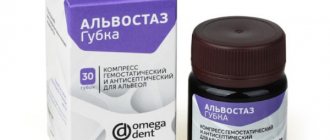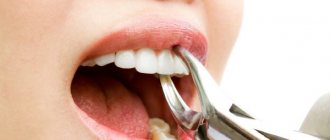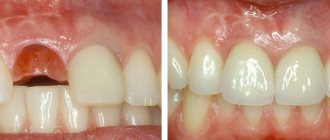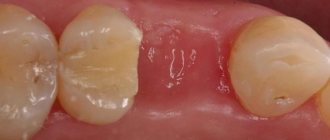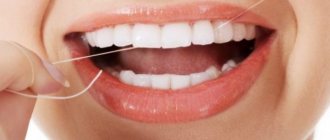920
After tooth extraction, a blood clot forms in the alveolar socket, stopping bleeding and protecting the wound from contamination and infection.
The formation of a blood clot is a prerequisite for high-quality and rapid healing of the hole. Its absence is considered a complication or, in any case, a prelude to it.
General overview
Usually, after a tooth is removed, the dental surgeon places a gauze turunda on the hole and asks the patient to squeeze it with his teeth. If everything goes well, after 20-30 minutes the turunda is removed, and the normal healing process continues in the socket, which ends completely after 2-3 weeks.
Sometimes, fortunately, relatively rarely, the primary bleeding does not stop, or it resumes later, thus becoming secondary.
This problem is solved by tamponade of the hole - filling it with iodomorphic bandage, fibrin glue, biological antiseptic tampon (BAT) or other material used to stop bleeding.
The most effective and modern means of stopping bleeding and eliminating other post-extraction complications are hemostatic sponges. These include alvostasis sponge, produced by the Russian company Omega-Dent.
Like other similar materials, alvostaz sponge is intended for filling wounds for preventive and therapeutic purposes. The drug has a complex effect:
- Absorbs exudate.
- Stops bleeding.
- Protects the wound from contamination and bacterial infection.
- Stops inflammation.
- Eliminates swelling.
- Pain relief.
And ultimately it prevents complications and speeds up healing.
Alvostaz sponge is a porous preparation in the form of a cube consisting of collagen impregnated with active and auxiliary medicinal solutions.
The material has an antiseptic, hemostatic (hemostatic), analgesic, and sorbing effect. It is used in dentistry mainly for the prevention and treatment of alveolitis.
If the sponge is installed immediately after tooth extraction, it performs a preventive function - preventing the development of alveolitis. If after continuous primary or secondary bleeding - therapeutic.
The cause of ongoing primary or renewed secondary bleeding may be:
- damage during extraction of large vessels;
- blood clotting disorders due to pathology of the body or the action of anticoagulants;
- destruction of a blood clot due to non-compliance with doctor's recommendations, for example, rinsing the mouth too vigorously with water or an antiseptic solution;
- inflammatory process in the hole;
- highly traumatic tooth extraction due to its characteristics (impacted tooth, third molar, etc.).
The drug is available in 3 forms - with iodoform, with chloramphenicol and neomycin, with chlorhexidine and metronidazole.
In what cases is suturing of the tooth socket performed, and what material is used.
Visit here to learn about the features of suture material for dental surgery.
At this address https://www.vash-dentist.ru/hirurgiya/udalenie-zubov/easy-graft-vosstanovlenie-defektov.html you will find a detailed description of the Easy Graft Classic bone replacement material.
Preventive measures for alveolitis
Any patient who has had a tooth removed can minimize the risk of developing the disease. To do this, he needs to strictly follow all the surgeon’s recommendations, namely:
- stop the bleeding in the first two hours after the procedure by placing a sterile tampon on the hole (you need to bite it firmly and hold it for at least half an hour);
- if a wisdom tooth has been removed and the bleeding lasts longer, take a hemostatic drug;
- Do not under any circumstances remove a blood clot that has formed in the socket;
- carry out hygienic brushing of teeth, being careful to avoid damage to the wound and displacement or destruction of the clot;
- Avoid consuming cold/hot, spicy/salty foods during the recovery period;
- refuse to take hot baths and visit baths and saunas;
- use anti-inflammatory drugs such as Metrogyl Denta.
You can eliminate the risk of developing alveolitis due to the doctor’s fault by making an appointment with CELT surgeons for removal... Well, if you are faced with this disease, get it treated with us by making an appointment online or contacting our information line operators: +7 (495) 788-33 -88.
Make an appointment through the application or by calling +7 +7 We work every day:
- Monday—Friday: 8.00—20.00
- Saturday: 8.00–18.00
- Sunday is a day off
The nearest metro and MCC stations to the clinic:
- Highway of Enthusiasts or Perovo
- Partisan
- Enthusiast Highway
Driving directions
Active components and principle of action
The properties and features of the action of different forms of the drug are determined by the composition of the impregnation:
- Alvostaz Sponge No. 1 (with iodoform) contains collagen, eugenol, calcium phosphate, lidocaine, iodoform, thymol, propolis.
- Alvostaz sponge No. 2 (with chlorhexidine and metronidazole) – collagen, dexamethasone, metronidazole, chlorhexidine.
- Alvostaz sponge No. 3 (with chloramphenicol and neomycin) contains collagen, neomycin sulfate, chloramphenicol, chlorhexidine, dexamethasone.
The individual components of sponge alvostasis have the following effects on the wound:
- Collagen absorbs exudate and blood, creates compression inside the socket that stops bleeding, and serves as a framework (matrix) for newly formed tissues. Having fulfilled its function, depending on its shape, it is resorbed or rejected by the hole.
- Eugenol (“clove oil”) is added as a flavoring agent.
- Iodoform and chlorhexidine have an antiseptic effect.
- Thymol is an antiseptic, anesthetic and preservative.
- Calcium phosphate has a complex effect. For dentists, its osteoregenerative function is most important.
- Lidocaine relieves pain.
- Propolis has antiseptic, antimicrobial, immunomodulatory and antioxidant effects.
- Dexamethasone is a glucocorticosteroid with an anti-inflammatory effect.
- Chloramphenicol and neomycin sulfate are broad-spectrum antibiotics.
- Metronidazole is an antiprotozoal (directed against protozoan parasitic microorganisms) and antimicrobial drug.
The product performs the following actions in relation to the wound:
- It swells from the adsorption of blood and exudate , tightly adhering to the walls of the socket.
- Stops bleeding. For uncomplicated primary bleeding, this takes 3-5 minutes. The duration of elimination in case of complicated primary or secondary depends on the clinical picture.
- Relieves pain for several hours.
- Causes accelerated healing of the hole thanks to the impregnation components.
- It resolves or is pushed out of the socket after 14-21 days.
The principle of action is determined by the action of their active substances. In particular, when reacting with wound exudate, iodoform releases free iodine, activating its antiseptic effect.
The antibiotics contained in the impregnation create a bactericidal and/or bacteriostatic effect.
Summing up
The drug is quite simple and easy to use, both for specialists and patients. The use of the drug helps prevent the development of alveolitis, helping to reduce the risks of possible complications. In addition, the rehabilitation period for patients is noticeably reduced. The product is effectively fixed in the required place.
There is not a single case of involuntary loss of a compress from a wound. The product acts as an antiseptic and quickly stops bleeding. The only drawback is the characteristic specific smell of the drug and its taste, which also passes quickly.
In terms of cost, Alvostaz is an affordable product for professional dentists and ordinary patients; its price varies between 500-700 rubles, depending on the form of release.
Release form and absorption time
The material is produced in the form of cubes measuring 1x1x1 cm. One package contains 30 cubes (sponges) placed in a plastic jar.
Resorption of resorbable cubes (alvostasis sponge No. 1) completely ends after 14-21 days. Rejection (pushing out of the hole) of non-resorbable ones (sponges No. 2, 3) - after a few days.
It is unacceptable to forcibly remove (tear off) material from the wound. It must be resorbed or rejected by healed tissue .
The mechanism of development of alveolar process atrophy and the degree of the pathological process.
In this publication, we will tell you which dentist recommendations should be followed without fail after a complex wisdom tooth removal.
Here https://www.vash-dentist.ru/hirurgiya/udalenie-zubov/pezohirurgiya-bez-boli.html everything about the use of piezosurgery in dentistry and its effectiveness.
Therapeutic effect
When the product is injected into the alveolus, it helps to quickly eliminate the inflammatory process, relieve the patient from pain and protect against possible swelling of the gums.
The effect of the sponge continues for several hours after surgery. While in the hole, the collagen sponges gradually and independently dissolve.
If the drug is used for prophylactic purposes, it ensures rapid healing of the resulting hole after tooth extraction. The whole process is painless, there is no feeling of discomfort or pain.
The composition of the drugs includes components that are characterized by activity directed against pathogenic carriers and bacterial deposits, resulting in a powerful bactericidal effect. Dexamethasone significantly reduces the duration of pain after surgery.
The product does not cause toxic poisoning and does not contribute to the formation of ulcerative lesions on the oral mucosa. In addition, all products actively suppress the activity of bacteria with pronounced resistance to penicillin and other antibiotics.
Indications and restrictions
Alvostasis sponge is indicated in most cases of maxillofacial surgery. In particular:
- to prevent complications after traumatic tooth extraction (most often during the extraction of wisdom teeth);
- for post-extraction complications - alveolitis, periodontal inflammation, abscissus;
- in the treatment of deep gum pockets (with open curettage);
- for various surgical interventions on the dentofacial apparatus, characterized by a medium or high degree of trauma.
The use of alvostasis sponges does not pose any danger to patients. They are contraindicated only for people with allergies to the components of the impregnation - iodine, eugenol, bee products, lidocaine.
From the series - I have an opinion
About effectiveness, safety and correct use.
Alvostaz is indeed a very good remedy and helps perfectly with alveolitis. The sponge takes on the role of filling blood after tooth extraction, while disinfecting the hole.
Provides a high guarantee that no infection will penetrate inside and healing will take place successfully and quite quickly.
Another significant advantage of this remedy is that when using it there is absolutely no pain, which is very important for patients. In my practice, I always use these products after tooth extraction. But it must be said that not all doctors adhere to this rule.
Surgeon - dentist
A week ago, I had a tooth removed, which had been causing me a lot of inconvenience for a long time. The doctor placed special hemostatic sponges into the wound.
He told me in great detail what this drug is and what it is for. I liked that no additional visit to the dentist is required, because this product should dissolve on its own.
After the anesthesia wore off, there was no pain or discomfort. And now the edges of the wound are already beginning to tighten.
Oleg, 38
Application technique
The technique of application depends on the type of operation, and may have its own characteristics depending on it. Let's look at it using the example of tooth extraction. Post-extraction use of the material involves the following procedures:
- Removal of dead, necrotic and infected tissue from the socket.
- Rinse the wound from bone and tissue fragments with saline solution heated to body temperature.
- Drying the cleaned hole with a hardware suction, pipette or gauze swab. Cotton swabs cannot be used due to the possibility of clogging the wound with cotton fibers (lint). Before this, it is necessary to ensure that the hole is isolated from saliva.
- Selecting an alvostasis sponge from a jar and filling the hole with it. This must be done with gloves and sterile tweezers.
- Suturing the wound, if necessary.
- Cover the wound with a sterile dry gauze pad.
In difficult cases, if wound healing is delayed, it can be treated multiple times and the old sponge replaced with a new one. Although in most cases once is enough.
The patient is informed that it is impossible to forcibly tear off the gauze swab; he must wait until it comes off on its own.
In the video, watch the process of using collagen hemostatic material.
Analogs
There are a sufficient number of complete or partial analogues of Alvostaz sponge on the pharmaceutical market:
- Alvostasis flagellum . Material from the same company as alvostaz sponge. Similar to it in composition and properties. It is a drug-impregnated collagen tourniquet with a cross-section of 1×1 cm. It has the same indications.
- Iodomorphic bandage. Cotton bandage soaked in iodoform. It has an adsorbent, homeostatic, anesthetic, antiseptic and bactericidal effect.
- Dental micro-tuffer. It consists of a collagen cone impregnated with sanviritrin (a broad-spectrum antibiotic) and lidocaine (an anesthetic). Resorbed in the wound.
- Alvanes sponge. It is lyophilized (cold-dried) collagen impregnated with antiseptic and antibacterial solutions.
Available in 2 forms - with iodoform and chlorhexidine and metronidazole. It has hemostatic, anesthetic (contains lidocaine), antibacterial, anti-inflammatory and astringent effects. Bioactive (stimulates tissue regeneration). It is resorbed in the wound within a few days. - Stimulus-Oss. It is a porous material consisting of hydroxyapatite and various additives. Available in the form of plates 50x50x7 mm and cones with a diameter of 11 mm.
In addition to hemostatic and bactericidal effects, it also has an osteoregenerating effect due to the presence of hydroxyapatite. Therefore, its scope of application is wider than that of alvostasis sponges.Used for any maxillofacial surgery where replacement of missing bone tissue is required. Can also be used after tooth extraction.
Reviews
In most cases, dental surgeons do not see the need to use alvostasis sponges or related materials with every tooth extraction.
The hole heals due to the formation of a blood clot. But if the latter is absent for some reason, the use of collagen sponges and other similar products becomes necessary.
If you have had a tooth removed using alvostasis sponges, tell us about your feelings and results of treatment. You can leave your comment at the bottom of this page.
If you find an error, please select a piece of text and press Ctrl+Enter.
Tags: tooth extraction
Did you like the article? stay tuned
Previous article
Universal dentures - a funny joke or a banal scam?
Next article
Perflex thermoplastics for the manufacture of dentures
